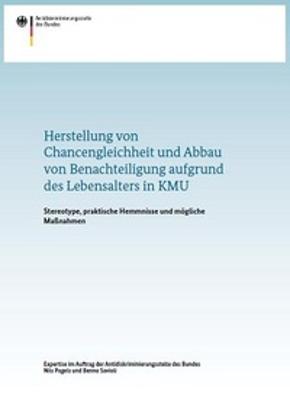Creating Equality and Eliminating Age-based Discrimination in Small and Medium-sized Enterprises
Stereotypes, practical obstacles and possible measures
- Factsheet on the research project -
Authors: Nils Pagels and Benno Savioli, published by the Federal Anti-Discrimination Agency (FADA) Year of publication: 2013
Brief overview
The objective of this expert opinion...
... is to determine the degree to which people are discriminated against because of their age by and in small and medium-sized enterprises (SMEs). At the same time, the expert opinion puts forward arguments in favour of mixed age working teams as well as counter-strategies and good practice examples for avoiding age discrimination in the workplace.
The basis for the expert opinion...
... is provided primarily by an analysis of the existing literature in this field. In the process, relevant jurisprudence was also taken into account. In addition, the authors conducted twelve interviews with selected experts from the areas of science, employers’ associations, trades unions, organisations for older persons, further training in the trades and programme initiatives.
Main results
Forms of discrimination
Access to the labour market
- Older, unemployed persons have fewer possibilities of returning to working life.
- Among younger persons, it is particularly those who have no vocational training who encounter discrimination, whereby owing to the effects of multiple discrimination, age discrimination tends to affect, not least, young people with a migrant background.
- Both young people and older persons are perceived through widespread stereotypes that could have a discriminating impact, particularly on personnel choices, whereby this impact seems to be independent of the size of the enterprise. Indeed it appears to be much more influenced by company culture and the attitudes of those in charge of personnel recruitment.
- Among the usual stereotypes applied to older persons one finds: lower productivity, lesser willingness to change/lack of flexibility, lower learning capacity, shorter retention times in the firm, higher cost, high reliability.
Disadvantages within working relationships
- Opportunities for further training are used predominantly by the middle age-group.
- As opportunities for further training are determined especially on the basis of what makes economic sense for the entire enterprise, older employees are often denied such possibilities in the light of their impending retirement.
- The share of the further training activity that falls to the SMEs is smaller than that of the large firms, although the further training rates in SMEs do not differ significantly from those of the large firms.
Ending working relationships
- Younger and older persons are especially affected by dismissals if the enterprise in question has to cope with an economic crisis.
On the whole, it should be noted that, with respect to age discrimination at work, according to current knowledge no significant differences result from an enterprise’s size. Rather, differences in the form and extent of age discrimination are primarily a question of company culture, working conditions and work organisation.
Counter-arguments and avoidance strategies
Advantages of working in mixed age teams:
- Co-operation among persons of different ages and varying degrees of experience could contribute to the development and productivity of the enterprise by facilitating the input of different skills, experience and background into the work process.
Two different approaches can be identified as basic concepts for enterprises seeking to avoid and combat age discrimination:
- Tool kits for an age-appropriate working environment in SMEs
building on the study of the same name conducted by Pfeiffer et al., 2012
whereby four areas of action can be differentiated:
- health und productivity;
- skill and competence;
- values, attitudes and motivation;
- work, organisation of work and leadership.
- The “life-phase oriented personnel policy” concept
building on Rump/Eilers/Wilms: Strategie für die Zukunft (Strategy for the Future), 2011
one of the objectives of which is the continued fostering of employability, the strengthening of employee loyalty to the firm, and an improved reconciliation of professional, private and family life. In each case, it is necessary for the approach to be established at management level and mainstreamed into all of the company’s operations.
Options for action
The authors recommend that enterprises:
- develop a stronger willingness to address age-related images and stereotypes,
- revise their personnel recruitment procedures to make them more age-sensitive,
- create good working conditions as an essential basis for equality,
- understand the avoidance of age discrimination as the prerequisite for the productivity of the enterprise,
- conduct analyses of the company’s age structure so as to determine the demand and the prerequisites for mixed age teamwork in the enterprise’s various areas of activity.
The authors recommend that policy makers:
- also create good working conditions as an essential foundation for equality,
- provide greater and more differentiated support and advice opportunities for enterprises seeking to combat age discrimination,
- discuss and fix age limits for employment based on individual cases and the interests of society and not in a rigid and calendrical manner.
- Furthermore, in the light of the poor data situation with respect to age discrimination in SMEs, increased research is required to analyse existing mechanisms and develop counter-strategies.

